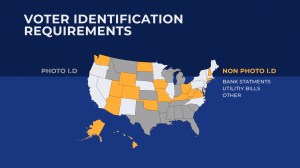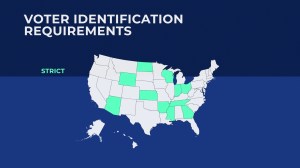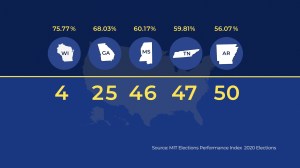There’s an awful lot of debate about voter identification. Some fact, some fiction and a surplus of opinions.
But what are the rules surrounding voter ID? Does it impact turnout? This article answers all those questions, but to sum it up: we certainly don’t have compelling evidence that there’s much to be gained from these requirements.
Overview of voter ID laws around the country
35 states have voter identification requirements that fall into two categories:
- ID type – photo ID vs. non-photo ID
- Level of enforcement – strict enforcement vs. non-strict enforcement

ID type: 17 states require a photo ID, which includes a drivers license, state issued ID or a passport, but that may still require proof of address. 18 states require a non-photo ID – which includes bank statements, utility bills or other official documents.
Level of enforcement: 11 states have strict enforcement – meaning voters who don’t have an ID cast a provisional ballot and then have to return with the approved documents. 24 states have non-strict enforcement which allows voters to cast a ballot as long as they sign an affidavit or an election official can verify their information.


The type of ID and level of enforcement varies and are separate from one another. A state can strictly enforce non-photo IDs like Ohio, or have non-strict enforcement of photo IDs like South Dakota.
The controversy surrounding voter ID laws is concentrated on strict enforcement of photo IDs in seven states: Arkansas, Georgia, Indiana, Kansas, Mississippi, Tennessee and Wisconsin.
Does Voter ID impact turnout?
The evidence is somewhat mixed. In the aggregate, there is no compelling evidence that voter identification rules have a big impact on turnout rates across the states. There is some evidence that once these rules are tightened there can be a minor decrease in turnout, but it’s not clear that it lasts more than one election.
 Data from MIT shows turnout varies in states with strict voter ID laws. Wisconsin has the 4th highest participation in the country, Georgia is right in the middle at 25th, while Mississippi, Tennessee, and Arkansas are among the worst.
Data from MIT shows turnout varies in states with strict voter ID laws. Wisconsin has the 4th highest participation in the country, Georgia is right in the middle at 25th, while Mississippi, Tennessee, and Arkansas are among the worst.
Turnout in the United states rose during the Trump-Clinton and the Trump-Biden presidential contests, so rules changes are swamped by the interest level and the psychology of the electorate.
It remains to be seen if voter ID laws disproportionately impact a certain demographic or political party. The rules have not been in place for a significant enough period of time and we haven’t had them in a sufficient number of states to see anything conclusive.
To learn more about voting in America, including voter registration and election systems, keep watching our series on Voter Integrity.